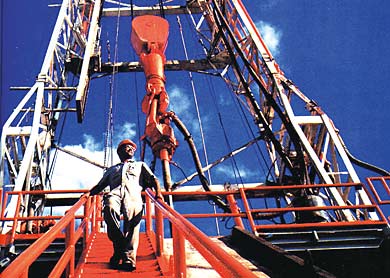The vice-minister of Energy and Mining, Luis Vierma, informed that his Ministry (MEM) expects to grant the licenses for gas exploration, extraction, and commercialization in the Gulf of Venezuela and Falcón reservoirs this year.
President Chávez will subscribe an agreement with the companies applying to participate in the bidding process for the eight sections of the “Rafael Urdaneta” project.

The MEM will hand each company -at a cost of 250,000 $- the package containing the corresponding data, in order to receive, within 90 days, the different bids that will be evaluated for a possible decision next November.
Only “if the bids are reasonable” will the MEM allocate the contracts, said Vierma, who assured that a total of twenty firms, including U.S., Russian, Norwegian, French, and local companies in the energy business, will compete to operate in the prospective areas.
According to the vice-Minister, the seismic survey determined the existence of “important geological structures”. The conditions of operation for the winning firms will include delivering volumes of gas in the internal market as well as sustainable development programs.
If the existence of gas reserves is corroborated in the Gulf and northeastern Falcón, this resource may be exported to Colombia through the binational gas pipeline, whose construction was recently ratified by the heads of state of both countries.
Félix Rodríguez, vice-president of Exploration and Production of the state owned oil company Pdvsa, affirmed last October that between six and seven areas had been detected in the Gulf and in the Falcón northeast, and that the decisions on the extraction of the mineral from these waters were under way.
The Gulf of Venezuela, northeast Falcón, Bahía de Barcelona, Norte de Paria, and Plataforma Deltana total 500,000 square kilometers of probably very important reserves of gas and petroleum.
With offshore extraction, Venezuela could twofold its current production, since the daily oil yield could rise by 2.5 million barrels. Only in the Gulf of Venezuela, the estimated reserves are 7 billion barrels. According to Pdvsa spokesmen, total potential offshore reserves could reach 18 billion barrels, besides 95 trillion cubic feet of gas.
In the Gulf and northeast Falcón, there could be total gas reserves of 23 trillion cubic feet.
In order to corroborate these estimations, it will be necessary to perform seismic surveys and perforation of 12 to 15 wells, according to non confirmed predictions made last year.
Urdaneta project
This project will reduce the gas deficit in western Venezuela by transporting this product to the Paraguaná and El Palito refineries. Part of this volume will be used for the secondary recovery of oil wells in Lake Maracaibo. The operations in the El Tablazo petrochemical complex in this region, will also benefit from the transportation of this derivative product.
According to the diagnostic performed a few months ago, Barracuda; the most promising of the blocks to be explored, 90 kilometers away from the Paraguaná refinery, is at most 50 meters below the surface, and thus the operations could be carried out with Pdvsa’s current water vehicle fleet.
Venezuela also expects to extract gas from the north of Paria (Mariscal Sucre Project) and the Plataforma Deltana. The Norwegian Statoil, and the U.S. Chevron Texaco, which received licenses for blocks 2, 3,and 4 of Plataforma Deltana, expect to begin operations by September, according to previous information.
Offshore development will require a liquefaction plant in Sucre state, that will be reached with a 270 kilometer pipeline.
 Articles by this author
Articles by this author











Stay In Touch
Follow us on social networks
Subscribe to weekly newsletter